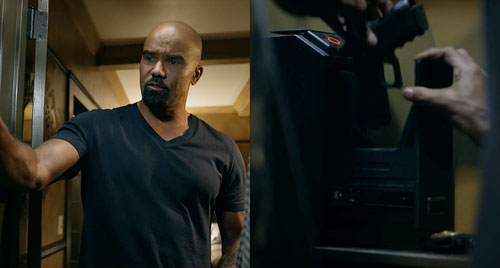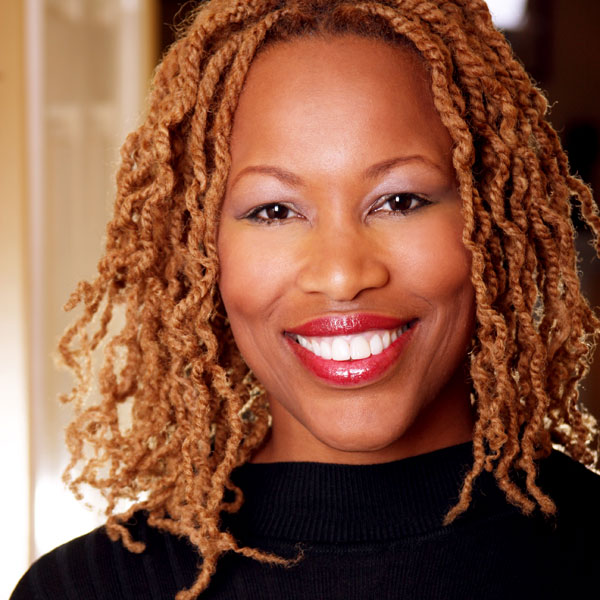WGAW writers and showrunners pledge to change the cultural narrative on firearms in America.
3/21/2025 • Evan Henerson
New PBS Contract Signals Progress
Supported by their strike authorization vote and solidarity, writers reach a deal.

WGAW writers and showrunners pledge to change the cultural narrative on firearms in America.
A gun safe can be high-tech, like something out of a sci-fi movie. So says WGAW member Andrew Dettmann whose series S.W.A.T. showcased—albeit very subtly—such a device during the series’ seventh season.
Sergeant Daniel “Hondo” Harrelson (played by Shemar Moore) uses the safe in the third episode of season 7, “Good for Nothing” (written by Alan Morgan). Returning home, Hondo goes to his bedroom closet to open the safe and store his gun before returning to the kitchen to talk to his wife, Nichelle (Rochelle Aytes).

“The digital one that our hero, Hondo, uses, you put your finger on it, it’s got the biometrics and it pops open,” said Dettmann, who is an executive producer and showrunner on S.W.A.T. “I think even for those who are into guns, having these extra accessories along the way can help emphasize the common-sense element of what we’re trying to do.”
Plotwise, the scene has no significance. Hondo and Nichelle have a small child in the house, so it makes sense that he would safely store his gun. The point is not that Hondo’s gun safe is high-tech, but that it’s there in his house and being put to use. Dettmann likened it to how other safety-related elements of everyday life now appear on screen.
“It’s like the ways Hollywood dealt with seat belts. All our characters put on seat belts,” Dettmann said. “Or the way they dealt with smoking. For the most part on TV, they have stopped showing main characters smoking. Hopefully it has some impact.”
Scenes like this one have earned S.W.A.T. plaudits from Brady: United Against Gun Violence, a Washington, D.C.-based gun violence prevention nonprofit. More than 300 writers, showrunners, producers, directors and other creatives have pledged their support to Brady’s Show Gun Safety campaign, an effort to “change the cultural narrative of firearms in America.”
Brady points to research that shows viewers follow the examples of people in the media in healthy and deleterious ways. Studies by Truth Initiative in 2015 and 2019 found that high percentages of adolescents cited smoking in movies as reasons they decided to start smoking or vaping. In terms of guns, a 2023 study published in JAMA Pediatrics concluded that children who had watched a gun safety videos were less likely to touch guns and pull the trigger of a gun they found and were more likely to tell an adult than those who hadn’t seen the video.

The Show Gun Safety campaign launched following the 2022 mass shooting at Robb Elementary School in Uvalde, Texas that resulted in the deaths of 19 students and two teachers. Since, a growing list of entertainment workers including many WGAW showrunners and writers have signed Brady’s open letter to the creative community promising to “use our collective power for good.” WGAW’s Writers Education Committee held a Zoom panel on the topic in December 2022, with showrunners and Brady Center President Kris Brown.
The Show Gun Safety principles include modeling responsible gun ownership and showing the consequences for reckless gun use; having at least one conversation during pre-production regarding the depiction of guns; and limiting scenes that include children and guns.
Dettmann was among a delegation of showrunners who went to the White House in the spring of 2023 to participate in a roundtable discussion with Brady and White House domestic policy advisors around the depiction of guns in film and television.

Every time another mass shooting happens, it just upsets everybody and yet people feel like there’s nothing they can do until Congress passes laws. Well, in the creative community, here’s something we can do.
- Glen Mazzara
“We’ve had an epidemic of gun violence in this country for as long as I can remember,” said showrunner Glen Mazzara. “Every time another mass shooting happens, it just upsets everybody and yet people feel like there’s nothing they can do until Congress passes laws. Well, in the creative community, here’s something we can do.”
When Show Gun Safety Initiative campaign organizers make their presentations to writers, showrunners and talent agencies, they stress that they are trying to make the topic of gun safety simple and relatable.

“When we get a script, we have to be able to look at the narrative drive, look at what they’re trying to say and build in safe storage in a way that continues the narrative, advances the narrative and doesn’t take away from it,” Brown said. “That’s been the most important component I would say, and that’s been driven by people who are part of Brady today who are also a part of the industry.”
For many in the creative community, awareness has morphed into action. S.W.A.T. has depicted characters retrieving or storing their weapons from safes located under beds or in car trunks. The CBS series is a police crime drama that, as Dettmann points out, has no shortage of guns or gunfire, but that doesn’t mean S.W.A.T.’s depictions of guns—in use or otherwise—should not be presented in a responsible way.
Brady advisors have made themselves available to help writers more accurately depict some of the consequences of gun violence. For medical dramas, Brady experts can give writers real-world perspective on everything from what a procedure operating on a child who has been shot looks like, to what their smocks look like after the surgery, to how distraught parents react when they are informed that their child has died.
“That is not always shown on TV and that’s not for every audience, but there are writers and showrunners who are hungry for that kind of information,” said Brown. “So what we’re really trying to do is have a broad approach to all kinds of different shows, not just the police procedurals.”

In the final season of Station 19, WGAW member Meghann Plunkett wrote a storyline for the episode titled “Good Grief” involving a mother who is urged to use an Extreme Risk Protection Order (ERPO, also known in some states as a red flag law) that would temporarily suspend her adult son’s access to his guns while he is considered a significant risk to himself or others. The idea for an ERPO story angle came from actor Jason George, a series regular on both Grey’s Anatomy and its spin-off Station 19. The Station 19 writers’ room discussed the idea and also consulted with Brady Chief Programs and Policy Officer Christian Heyne.
“As a room, we really spent a long time talking about what it would mean to have a storyline that didn’t shut down the perspective of someone who owns guns or someone who really feels that gun laws are maybe out of control—the point of view of someone that is not particularly my point of view,” said Plunkett, an executive story editor on the series. “The goal for the whole episode was to let people know that this law is something that exists, and I think that in that it really was successful.”
The series’ executive producer Zoanne Clack, a former emergency medicine physician and self- described “huge gun law advocate,” confessed that she had not been aware of ERPOs when George brought the idea to her and fellow executive producer Peter Paige. Having previously produced Grey’s Anatomy episodes that dealt with the effects of gun violence, Clack was all in.

“One of the reasons I picked the residency that I did at Emory University is because we had a new residency director who had done a lot of gun law and gun safety advocacy,” said Clack. “I always kind of thought that somewhere in there would be my niche if I stayed in public health. I felt like Jason brought it to us because he knew we would be open to it. I just feel like I have a deep personal goal to try to get some knowledge out there about gun safety.”
Mazzara is preparing to start a new series that will include a lot of gun use. He brought the Brady consultants to speak to his writers “on day one.”
“As we’re developing the show, breaking stories, and writing scripts, we’re having conversations. It forces us to pay attention in a way that I haven’t had to do on other shows,” Mazzara said. “Like anything, it takes a little while to change behavior, but I think this can become common practice.”